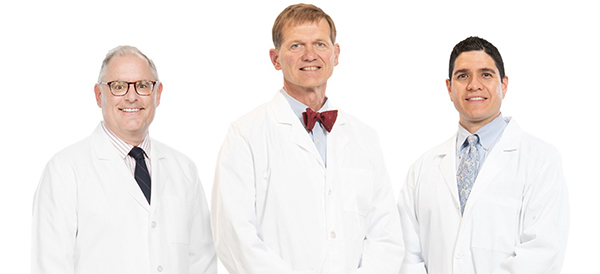
Alternatives to Hip Replacement
Hip replacement is by far the best solution for severe arthritis (loss of articular cartilage) of the hip. However in some situations there is significant hip pain when the articular (surface) cartilage is still mostly intact. Patients who have hip impingement, hip dysplasia or osteonecrosis in the early stages of these conditions may be better served with other surgical options. Symptoms can often be significantly improved and the joint may be preserved for many years.
Click the headings below to learn more about the different alternatives to total hip repalcement.
first
Your content goes here. Edit or remove this text inline or in the module Content settings. You can also style every aspect of this content in the module Design settings and even apply custom CSS to this text in the module Advanced settings.
Arthroscopic Hip Surgery
Arthroscopic hip surgery may be indicated for impingement syndromes, labral tears and loose bodies. Many orthopedic surgeons commonly perform arthroscopic knee and shoulder surgery. But arthroscopic hip surgery is more complicated and has been mastered by only a small number of surgeons. If you are considering this option, be sure to consult a surgeon who has experience with several hundreds of these operations.
The most common problem with hip arthroscopy is removing a torn labrum without addressing the underlying impingement deformity. This may provide temporary relief, but is not long lasting. Another error is when impingement surgery is performed when too much articular cartilage damage has already occurred. These mistakes are frequently made by inexperienced surgeons. When impingement surgery is performed on patients with minimal articular cartilage loss, more than 80% of patients have improvement in their symptoms.
The hope is that the hip joint will be preserved by this intervention, but this has no yet been proven. The ideal patient for impingement surgery is under 40 years with minimal arthritic changes on their hip x-ray. In these cases it is advisable to perform impingement surgery rather than hip replacement.
Arthroscopic Hip surgeons that I recommend are:
- Allston Stubbs – Winston Salem, NC
- Thomas Byrd – Nashville, TN
- Marc Phillipon – Vail, CO
Impingement surgery can also be performed through mini open anterior approaches or through more extensive approaches. It has not been proven.
Ganz Periacetabular Osteotomy
Ganz Periacetabular osteotomy is most useful for patients with hip dysplasia. Procedures that realign the position of the acetabulum (socket) are called osteotomies. Many different types have been promoted in the past for young patients with hip dysplasia. 90% of dysplasia cases occur in young women. These women typically were born with mild hip deformities that do not cause problems when they are children.
The elements of the dysplasia deformity are: oval shallow socket, steeply oriented socket, flattened oval head, narrow, valgus and anteverted neck, hypertrophied labrum. Typically these women have extremely loose ligaments and have much higher than normal hip mobility. They gravitate towards gymnastics and ballet because of their extreme flexibility. They start exhibiting mild hip symptoms in their 20s and 30s.
The hips start to fail early for two reasons: incongruency and instability. A normal hip is a spinning sphere. When an oval dysplastic hip rotates, abnormal forces are experienced by the articular cartilage leading to deterioration. A shallow dysplastic hip is poorly contained. If the orientation is more vertical, the situation is worse. The labrum hypertrophies in an attempt to better contain the head.
The result is a hip that is highly mobile. But the labrum eventually gets overloaded and fails. The first symptoms usually appear in the 20s and 30s depending on severity of the deformity and possibly activity level. At this point the articular cartilage may still be relatively normal.
If their socket orientation is too steep, a Ganz periacetabular osteotomy can improve symptoms by reorienting the entire socket and thereby better containing the head. If socket orientation is acceptable, sometimes the early symptoms are coming from a tear of the hypertrophied labrum that can be repaired arthroscopically. Removing torn labrum in dysplasia is not advisable because this destabilizes the head and may speed up the hip degeneration.
Studies on acetabular osteotomies have shown over 90% success in symptom relief if there is only minor articular cartilage damage at the time of surgery. The hope is that the hip joint will be preserved by this intervention, but this has not yet been proven. The ideal patient for osteotomy surgery is under 40 years with minimal arthritic changes on their hip x-ray. The problem is that there is no way of completely correcting the deformity. There is no way to deepen the socket or make the bearing spherical without destroying the cartilage. A hip resurfacing does accomplish these goals, but this requires an artificial implant.
Experts in Ganz osteotomy that I can recommend are:
- Michael Millis – Boston MA
- Robert Trousdale – Rochester MN
Free Vascularized Fibular Graft
Free vascularized fibular graft is an operation that can reestablish blood flow to the femoral head. In osteonecrosis (aka avascular necrosis or AVN) the blood flow to the femoral head is impaired. The bone dies. Sometimes blood flow is reestablished and it heals spontaneously. If blood flow remains cut off, the dead bone eventually dies and the head collapses. This is stage 3 osteonecrosis. At this point hip replacement is the only effective treatment.
The femoral head is by far the most common bone in the body to develop osteonecrosis. It is most often caused by excess alcohol consumption, prolonged high dose steroid use (prednisone type, not muscle building steroids), major hip trauma (fracture or dislocation, not a hard fall on the hip) or sickle cell disease. Exactly why these cause necrosis is not known. Clearly, there is some individual susceptibility because only a small percentage of patients exposed to alcohol and steroids get osteonecrosis. About 1/3 of cases do not have any associated risk factors and are labeled “idiopathic”.
In the earlier stages, before collapse, there are often mild symptoms. There are several operations that have been promoted to induce new blood flow to the femoral head in order to heal it before it collapses. The only one that I believe is effective is the free vascularized fibular graft. It is a complicated operation that only a few surgeons routinely perform.
The fibula is a small bone in the leg that is removed together with its blood supply. The bone is inserted through a large hole drilled through the femoral neck into the femoral head. The blood vessels are re-connected to new vessels near the hip. New blood flow is now brought directly in contact with the dead bone in the femoral head. When this operation is done prior to head collapse, the dead bone can heal and the hip joint is preserved in 95% of cases. If the head is already collapsed there is no point to this operation because the joint cartilage has already lost its support and will always fail.
The problems with this operation are complexity, long recovery, and donor site morbidity. This is a long and complicated operation that requires multiple surgeons and is very expensive. Patients are usually required to stay on crutches for months after the operation. It is relatively safe to remove a 3-4 inch section of fibula from just above the ankle, because the larger tibia can take the load. But some residual leg or ankle pain may be present permanently. Also clawing of the toes may result as a complication of removing the fibula. In stage 1 and 2 of necrosis in a young patient I think it is worthwhile to consider this option.
I recommend Duke University Orthopedics – who have the most experience with this operation.
Core Decompression
Core decompression is a simple operation where drill holes are placed through the neck into the head of the femur. The hope is that new blood vessels will grow through these drill holes to re-vascularize the dead portions of the head. Many contradictory studies have been published. I am not convinced that there is any value to this operation and I do not perform it. Other surgeons still routinely offer this operation. There is some hope that injecting new bone growth stimulators (such as infuse) through the drill holes might improve the results. I have tried this in 10 patients, but I abandoned it after 5 failed within 1 year requiring hip replacement. I continue to hope that others will discover a technique to make this work.
Resection Arthroplasty of the Hip
Resection arthroplasty of the hip is a salvage operation for failed hip replacements that for some reason cannot be revised. It was developed by a man by the name of Girdlestone and is frequently referred to as the “Girdlestone Procedure”. It was originally used over 50 years ago as an operation to treat severe arthritis of the hip by removing the entire ball portion of the upper end of the femur.
This essentially removes the hip joint and allows the femur to shorten. Scar tissue develops between the upper end of the femur and the pelvis bone and allows motion with minimal pain. The leg, however, is quite short and weak and usually patients require at least a cane and often two crutches to walk. The older the patient, the more difficult it is to walk with a resection arthroplasty.
Hip Fusion
Hip fusion or arthrodesis is an operation where inducing the bone to grow across the joint ends the motion of the hip. It was once an operation used to treat very young patients with severe arthritis. Today, I no longer see any use for it. Although hip pain disappears after this operation, a severe limp due to loss of hip motion is permanent. After many years, arthritis in the knee and back begins to develop because these joints are overstressed.
Hemiarthroplasty
Hemiarthroplasty is when half of the hip joint is replaced. It is always the femoral rather than the acetabular half that is replaced. There are two versions: hemi resurfacing and endoprosthesis.
Hemi resurfacing was once used for stage 3 osteonecrosis. But now that total resurfacing is available, there is no longer any role for hemi resurfacing. Pain relief is incomplete in active people when only the femoral side is resurfaced, even when the acetabular cartilage is normal.
Endoprosthesis is still a useful option for elderly people who suffer a femoral neck (hip) fracture. If the patient is very active a stemmed total hip is superior, but if the patient is not very active, an endoprosthesis is a better solution.

